Fine art
Fine arts: history, directions, types
The history of art spans tens of thousands of years — the people of the most ancient civilizations used the methods available to them to depict objects that were significant to them. From early times to the present day, there have been many artistic movements, each with features that reflect the political and social characteristics of the period in which they arose. We talk about the history of fine arts, types and main directions.
Fine art history
Painting is one of the ancient arts, which over the course of many centuries has evolved from Paleolithic rock paintings to the latest trends of the 20th and even the 21st centuries. This art was born almost with the advent of mankind. Ancient people felt the need to depict the world around them on the surface. They drew everything they saw: animals, nature, hunting scenes. For painting, they used something similar to paints made from natural materials. These were earth colors, charcoal, black soot. The brushes were made from animal hair, or simply painted with fingers.
Ancient art (~ 4000 BC–400 AD)
The history of painting dates back to the time when a person first depicted something on the surface with the help of paint. This happened, according to scientific data, 40-12 thousand years ago, in the era of the late Paleolithic. This is evidenced by the preserved rock paintings in caves in the territories of Southern France, Northern Spain and other countries.
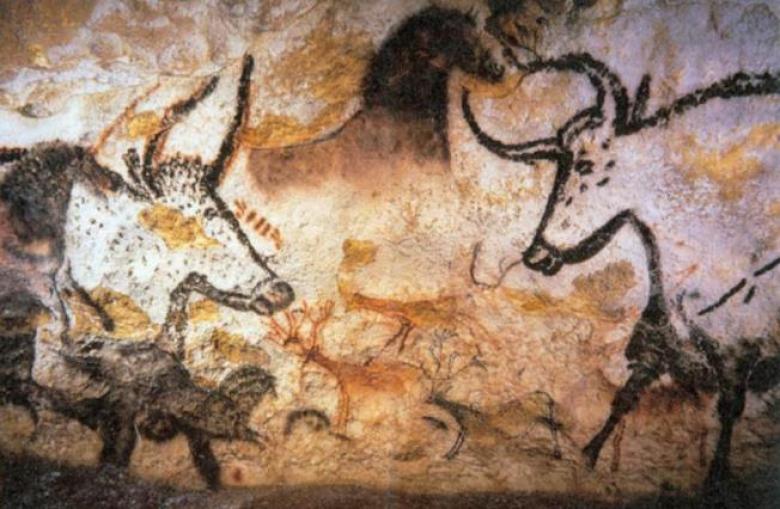
Paleolithic rock paintings (Lascaux cave in France)
The works of art of this period differed in different civilizations, but most of the works served the same purposes: to tell stories, decorate household items (utensils and weapons), depict religious and symbolic images, and demonstrate social status.
Medieval Art (AD 500–1400)
Painting in the Middle Ages acquired a religious character. Artists no longer sought to reflect reality on canvas. The transmission of spirituality became important. Even if the work was not an icon, it was still devoid of volume and perspective. The characters were located on the same line and looked flat, primitive.
Renaissance Art (1400-1600)
Everything changed with the advent of the Renaissance. Artists, following the mood in society, tried to guess the fashion trends in painting and follow them. Landscape and portrait became independent genres. New technologies have emerged. Everything looked decorous and noble until the 17th-18th centuries, when the Catholic Church lost its former significance and power. Masters of painting, no longer fearing the Inquisition, began to paint the most truthful pictures, reflecting the true appearance of the people of that era, their everyday life.
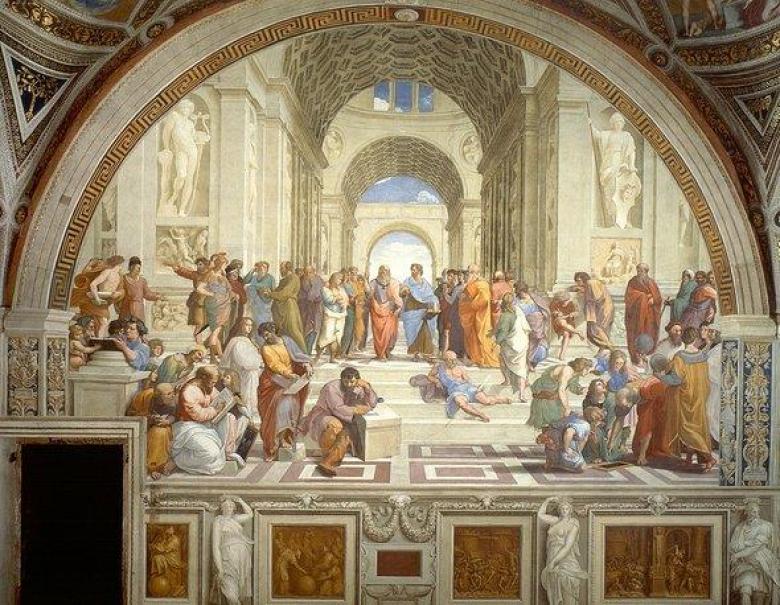
School of Athens (Raphael, Rome, 1510)
The great artists Leonardo da Vinci, Michelangelo, Raphael appeared precisely in the Renaissance.
Baroque (1600–1750)
The term comes from an Italian word used during the Middle Ages to describe the rejection of schematic logic. Subsequently, the word came to mean any distorted idea or a special process of thinking. Another possible source is the Portuguese word "Barroco" (Spanish "Barrueco"), used to describe the imperfect shape of a pearl. The history of works in the style has about 200 years - the development of the era lasted from the 1600s to the 1700s.
In art history, the word baroque is used to describe everything whimsical, asymmetric, unusual, bright, symbolizing the rejection of established rules and proportions. This idea appeared thanks to the critics of the 17th century. Until the end of the 19th century, this term always carried the connotation of the grotesque, exaggeration, excess of scenery, pomp. Only in 1888, the term began to be used as a designation of a stylistic direction, and not as a concept that criticizes redundancy, excess in painting. The baroque style of writing an emotionally rich picture had a profound impact on all forms of art, including architecture and sculpture. It is in painting that this direction of art is most pronounced.
Rococo (1699–1780)
The word "rococo" combines the French word "rocaille" (shell, decorative shell, crushed stone) and "baroque" - an Italian art style that precedes the period in question. Baroque is characterized by splendor, brightness, dynamism, the desire for excesses and luxury. Rococo in painting has become a more sophisticated and intimate analogue of the Baroque. France is considered the birthplace of the style, where the direction developed from 1720 to 1760. Despite the emergence of other trends, Rococo remained as a favorite style of the upper classes until the end of the century.
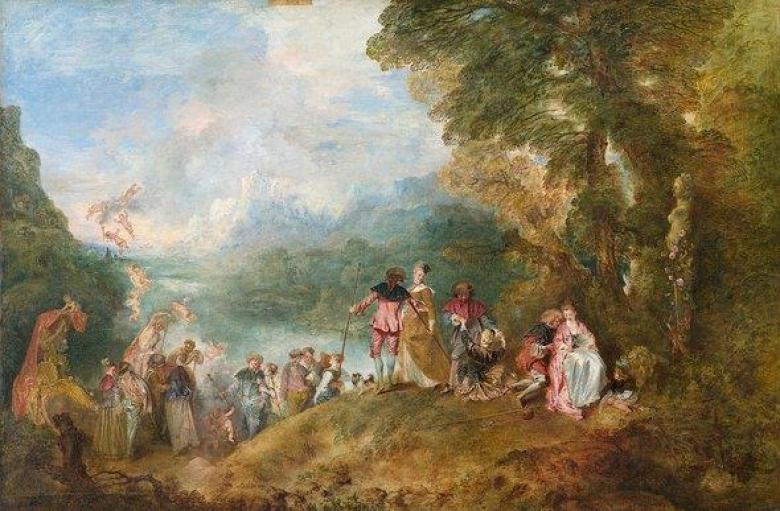
Pilgrimage to the island of Cythera (Antoine Vato, Paris, 1717)
The term "rococo" began to be used to designate the style in the 19th century. Initially, he determined the type of decoration of grottoes and fountains with the help of natural stone. The purpose of the decor is to create the illusion of natural fossils, symmetrical or asymmetrical. At the time of the appearance of the style, artists and critics called it a manifestation of bad taste, because the style lacked aesthetics and practicality.
Neoclassicism (1750–1850)
There are two art criticism approaches to the consideration of neoclassicism. In the first version, this term combines trends that arose at the end of the 18th - beginning of the 19th century. The era of neoclassicism coincided with the work of Jacques-Louis David. In the second, this term refers to the unification of styles that dominated the period of the 19th-20th centuries. Representatives of neoclassicism took as a basis the canons of ancient art, the Renaissance style, and classicism. This term is also called the retrospective style of the first half of the 20th century.
Romanticism (1780–1850)
Romanticism (romantisme) is a large-scale ideological and artistic trend in the culture and art of the 19th century, which replaced the cold rationalism of neoclassicism and the Enlightenment. Romantics exalted the importance of fantasy, emotions, feelings and spiritual throwing. In literature and art, the era of heroes with strong, daring, contradictory and sometimes rebellious characters began. These are figures of the Byron and Promethean types, which either proclaim the greatness of man, or become a toy in the hands of fate. They are overwhelmed by passions, they embark on wanderings and climb the barricades, raise the banner of freedom and do not know peace.
Realism (1848–1900)
Realism (from the late Latin reƒБlis - "real") is usually considered as the beginning of the development of modern art. In the literal sense, “realism” is an artistic style that truthfully and objectively reproduces reality in all its details, regardless of the degree of beauty depicted in the picture.
Art Nouveau (1890–1910)
In European countries and North American countries, the style had different names, one of which “art nouveau” (art nouveau) literally translates as “new art”. During the modern period, an attempt was made to create a completely authentic art, free from imitation of previous styles.

Fruit (Alphonse Mucha, 1897)
Art Nouveau - an international style in the fine arts Curved and wavy lines have become its characteristic feature, giving the image elegance and airy lightness.
Impressionism (1865–1885)
This artistic movement was born in France in the 1860s. The name was given to it by a painting by Claude Monet, presented at the first Impressionist exhibition in 1874 and called Impression: Sunrise - “Impression. Sunrise". Other Impressionists included: Renoir, Manet, Degas, Pissarro, Cezanne, Mary Cassatt, Sisley, Seurat and Signac, although Cezanne, Gauguin and Van Gogh are often called post-impressionists. Like the realists in the previous period, the Impressionists created scenes from contemporary life and landscapes in the open air.
The Impressionists were in many ways innovators. They tried to capture and capture a fleeting "impression", full of light and movement, and rejected the ponderous pictorial drawing.
They used unusual angles and experimented with brushwork to see what effect a combination of different colors and stroke textures would have. The influence of the Impressionists on the visual arts was very profound. For example, Van Gogh markedly influenced the expressionists, Cezanne - the cubists, and Monet - the representatives of abstract expressionism.
Post-Impressionism (1885–1910)
Post-Impressionism is the collective name for many disparate trends in painting of the late 19th and early 20th centuries. During that period, new art schools were formed, which had a strong influence on each other. Post-Impressionism hastened the completion of the transition from traditional academic art to the pictorial styles of the 20th century.
Expressionism (1905–1920)
Expressionism (from Latin expressio, “expression”) is a trend in European art that has received the greatest development in the first decades of the twentieth century, mainly in Germany and Austria. Expressionism seeks not so much to display the surrounding world as to express the emotional state of the author in artistic ways.
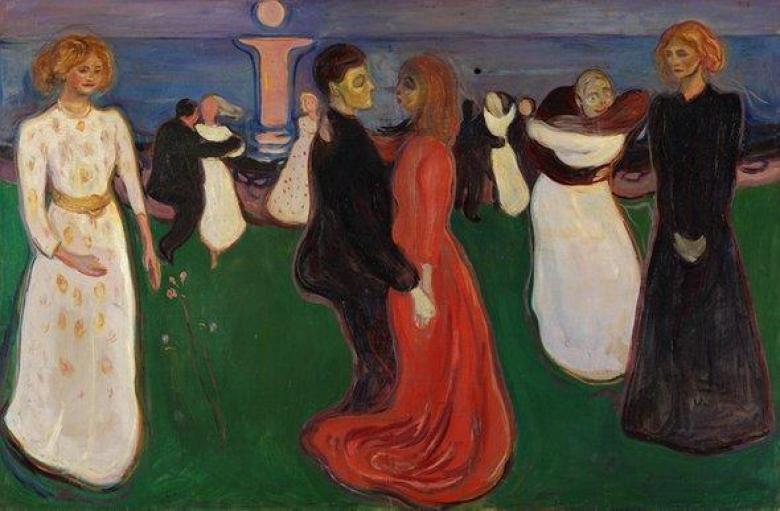
Dance of Life (Edvard Munch, 1899)
The German expressionists considered their predecessors the post-impressionists, who, discovering new possibilities of color and line, moved from reproducing reality to expressing their own subjective states. The dramatic canvases of Vincent van Gogh, Edvard Munch and James Ensor are permeated with overwhelming emotions of delight, indignation, horror.
Surrealism (1916–1950)
Surrealism is a trend in modern painting, literature and cinema that originated in France in the 1920s. In the center of the direction are allusions and paradoxes. Surrealists create on the basis of fantasy, dreams and imagination and do not recognize any limits. The founder of surrealism is the writer and poet Andre Breton, the author of the first manifesto of surrealism.
The French prefix "sur-" means "super-", that is, more than reality. The main goals of surrealism are to go beyond reality, to try to reflect dreams, fantasies, thoughts from the hidden corners of the subconscious.
Pop art (1950s–1960s)
Pop art is a direction in art based on objects of mass culture and aimed at entertainment, commerce, and not at the search for deep meaning, philosophy and spirituality. The leading role in the development of the direction was played by: advertising, fashion, trends, style icons, various means of popularization and commercial promotion. Pop art was a reaction to the seriousness of abstract art and other art styles of the 20th century. The style is called one of the offshoots of avant-garde art.
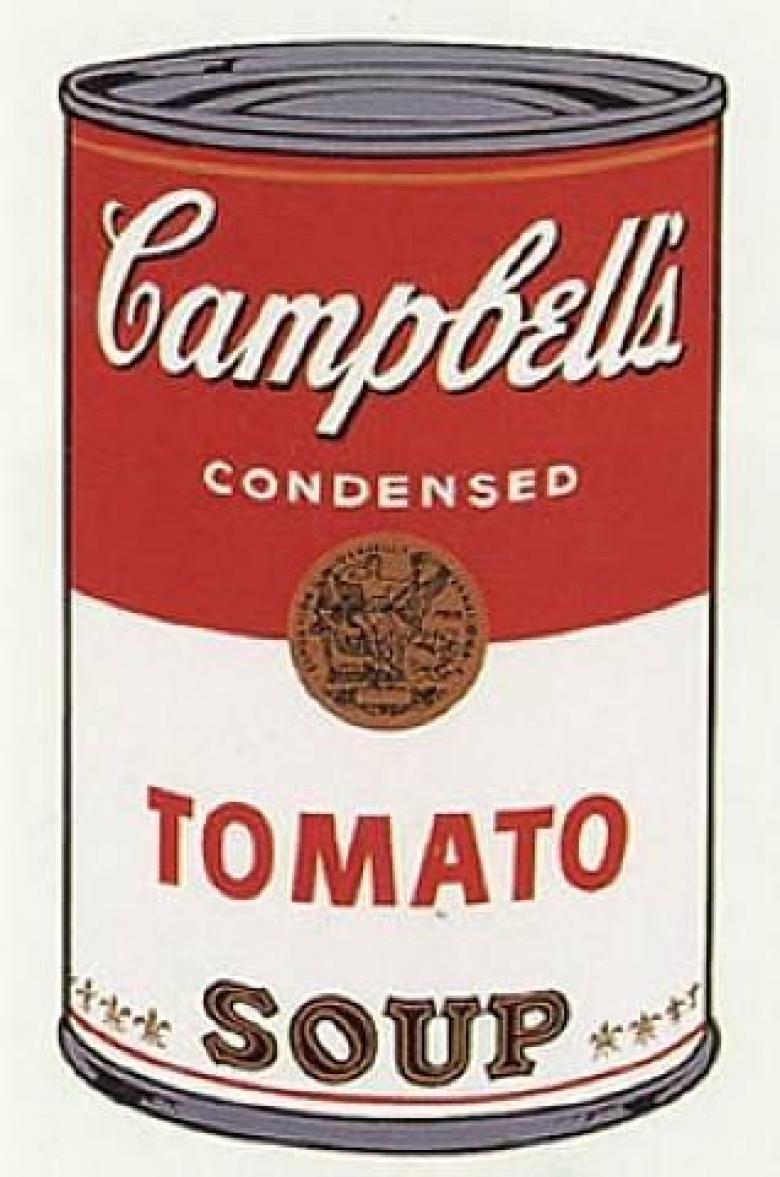
Can of Campbell's Soup (Rice-Tomato) (Andy Warhol, 1968)
The movement was founded in the 1950s and peaked in the 1960s. The birthplace of pop art is Great Britain, but the movement reached its greatest development in the USA, where New York became the capital of this cultural trend. The founders and most famous creators of pop art were Andy Warhol and Jasper Johns.
Contemporary Art (1970s–Present)
Contemporary art combines the entire spectrum of trends, trends and genres that have been addressed by authors from the end of the 20th century to the present day. In the context of globalization and the development of technology, artists create incredibly diverse works. It is difficult to find common features and common principles in contemporary art - it is so individual and diverse. Genres and cultural traditions interpenetrate each other, and artists continue to look for new ways of expressing themselves and current topics.
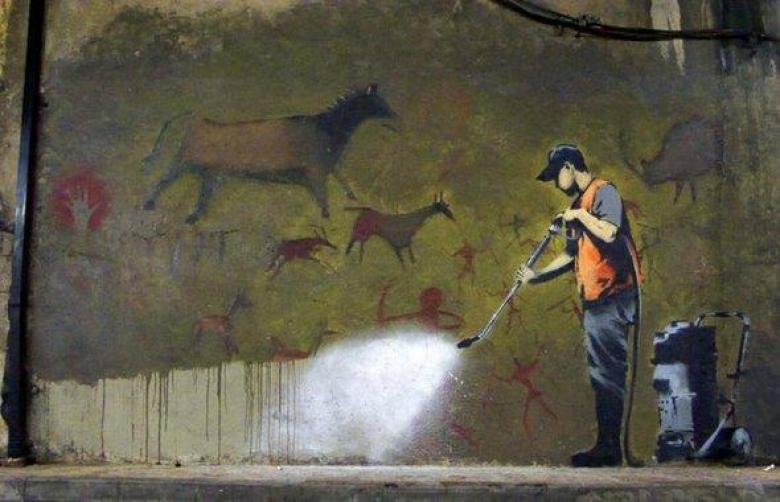
Wall Wash (Banksy, 2008)
Contemporary art in the West is designated by two terms: art modern and contemporary art. The first characterizes the creative processes from the end of the 19th century to about the middle of the last century. The second refers to works from the post-war to the present. But even this division is no longer enough. Time passes, and yesterday's cutting-edge works become history. Museums of contemporary art feel this especially acutely, as their acquisitions gradually become obsolete. Currently, it is customary to refer to contemporary art works created over the past 50, 30 or 20 years.
Types of fine art
Fine arts are classified according to the objects of application of creative efforts, the artistic and technical means used, and the historically established concepts of creativity. There are the following types:
- sculpture;
- painting;
- graphics;
- photographic art;
- arts and crafts.
Architecture as the design of buildings does not belong to the fine arts in the strict sense, but constantly interacts with and is stylistically consistent with it. Fine arts, with a sufficient measure of conventionality, include actions of actionism and some other visual works of indefinite affiliation. Poetry, film, dance, theater, performing arts do not belong to painting. Photography, calligraphy, mosaic, printmaking (print from an engraving) are separate genres of fine art.
Art photography
Fine art photography has a lot in common with landscape photography, portrait photography, and many other styles. The peculiarity of this genre lies in the fact that in it the photographer expresses his own artistic vision.

Ansel Adams, Teton Peaks and the Snake River (1942)
Unlike photojournalism or commercial photography, fine art photography is the photographer's attempt to express their ideas without being dependent on external demands or influences. Fine art photography is an opportunity for the artist to bring their ideas to life and try to interact with the audience. The result of the artist's work can be landscapes, portraits, still lifes or abstract images.
Museum of Fine Arts
The list of the most visited art museums in the world lists the 100 most interesting museums and galleries among visitors, the exhibitions of which mainly consist of works of art:
- Louvre - (Paris, France);
- Metropolitan Museum of Art - (New York USA);
- Vatican Museums - Vatican (Rome);
- State Museum of Modern Art - Paris (France);
- State Hermitage - St. Petersburg (Russia);
- New York Museum of Modern Art - New York (USA);
- Prado - Madrid (Spain);
- Moscow Kremlin - Moscow (Russia);
- New Acropolis Museum - Athens (Greece);
- University of Fine Arts - Rome (Italy);
- State Tretyakov Fine Art Gallery - Moscow (Russia);
- Doge's Palace - Venice (Italy);
- State Russian Museum (large collection of fine arts) - St. Petersburg (Russia);
- Solomon Guggenheim Museum - New York (USA);
- Pushkin State Museum of Fine Arts - Moscow (Russia);
- Museum of Fine Arts - Boston (USA).
Most of the museums on the list are located on the territory of the European continent and North America.
Classical fine arts
Classical art is the art of Ancient Greece and Ancient Rome during their heyday, as well as the art of the Renaissance and Classicism, which was directly based on ancient traditions. Classicism is called the aesthetic trend in the culture and art of Europe in the XVII-XIX centuries. The masters who worked in this style sought to revive the canons of ancient times, to focus on the clarity and simplicity of composition, shapes, and geometry. Prominent representatives of the first wave are Poussin and Lorrain. The second period, called neoclassicism, is the time of David, Ingres, Mengs. In Russia, this direction in painting was represented by Bryullov, as well as portrait painters Rokotov and Levitsky.
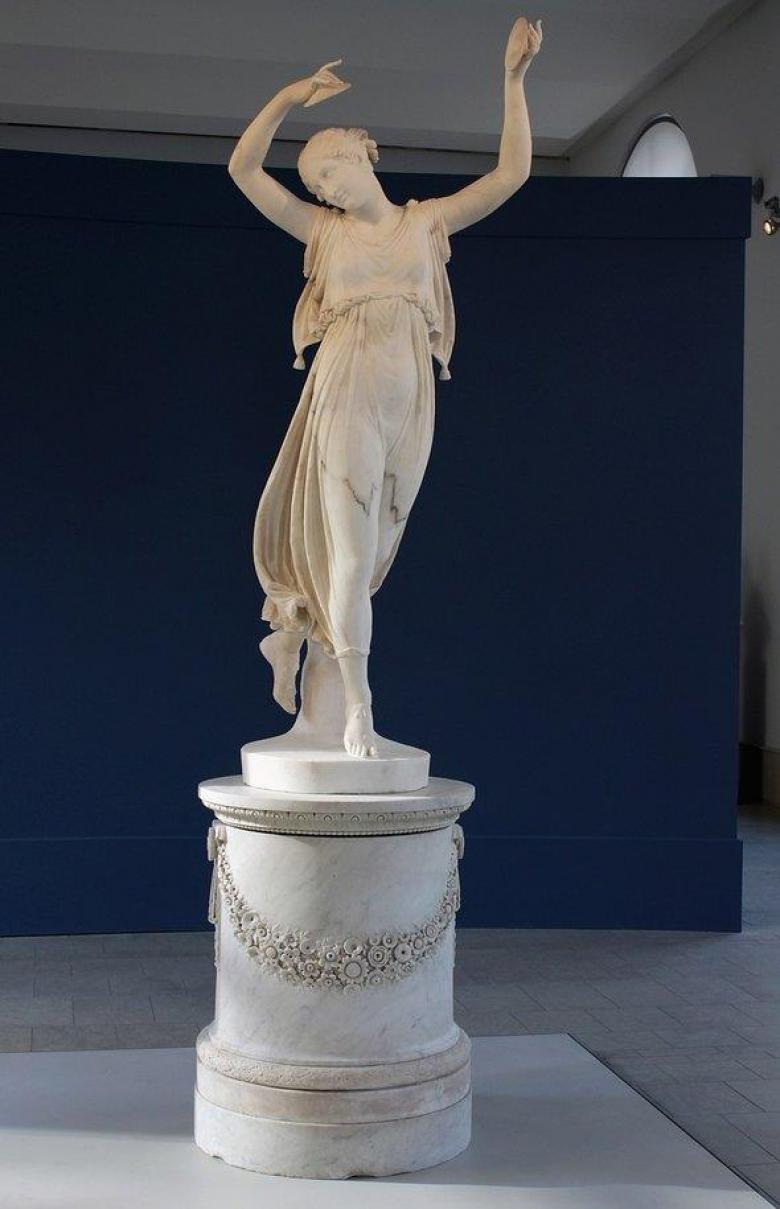
Dancer with cymbals (Antonio Canova, Venice, 1809-14)
Classicism as a phenomenon appeared in France in the 17th century. Over time, the new trend reached all the leading countries of the Old World: Britain, Germany, Spain, the Russian Empire. The very deep essence of the direction of classicism lies in its name. In Latin, classicus literally means "exemplary", "highest". So called those representatives of ancient Roman society, who were attributed to the highest class.
It was the art of the ancient Greeks and Romans that was raised to the standard by the creators of classicism. They perceived it as an ideal that should be brought back to life in modern realities. In their works, supporters of the fresh trend were eager to know the true essence, the truth of things and phenomena. The main task was considered to help a person to revive or for the first time find in himself the principles of morality, morality, and then live according to them.
Also, in the works of the classicists, the rules of the superiority of the higher over the petty, personal, earthly are often laid down. The universe as a standard and at the same time a prototype of everything - this is what was considered the basis of the worldview. Classicism affects only deep meanings, operates with eternal categories, without focusing on the particular, superficial. Painting, sculpture, structure: any work is made according to clearly defined canons, logical and well-established, like the Universe.
Genres
It was in the era of classicism that a clear hierarchy of genres was built. From now on, they were divided into two categories - high and low. The first type included painting on the themes of history, mythology, religion, the second - portrait, landscape and still life. High genres endowed with a deep, significant meaning, and the exact opposite attitude was towards low ones. Mixing these two categories was strictly prohibited.
Portrait
The main features of the genre were set by the "father" of classicism, Nicolas Poussin. It is in his "Self-portrait" that the main artistic credo is concentrated: expressive, somewhat embellished facial features, a clearly sustained composition, and rigor of form.

Dmitry Golitsyn, Rokotov
Another iconic example later became Jacques Louis David, captured on the canvas by himself. This genre of classicism also developed well in the Russian Empire. “Portrait of Catherine II” by Levitsky, “Dmitry Golitsyn” and “Grigory Orlov” by Rokotov are illustrative examples.
Landscape
Natural landscapes were made an integral part of the Classicism style by Claude Lorrain. In his works, the landscape organically complements the ruins of buildings and, at the same time, opposes them. There is a struggle between the eternal and the perishable. Fine examples of Lorrain's classicism are "Landscape with Apollo and Marsyas", "Morning in the harbor", "Departure of the Queen of Sheba".
Still life
In its own way, the development of style took place in Holland. There, the characteristic features of classicism were most clearly manifested in the still life technique in the 17th-18th centuries. Outstanding representatives - Willem van Aelst, Abraham Mignon. The Dutch classicist still life reached its highest color under Jan van Huysum. He became a brilliant master of the genre. “Flowers and Fruits” by van Huysum is almost a reference example of a late still life.
Contemporary visual arts
Contemporary art in its present form was formed at the turn of the 1960s and 70s. The artistic searches of that time can be characterized as a search for alternatives to modernism (often this resulted in denial through the introduction of principles directly opposite to modernism). This was expressed in the search for new images, new means and materials of expression, up to the dematerialization of the object (performances and happenings). The main goal was to distort the concept of spirituality. Many artists followed the French philosophers who coined the term "postmodernism". It can be said that there has been a shift from the object itself to the process.
The most notable phenomena of the turn of the 1960s and 1970s can be called the development of conceptual art and minimalism. In the 1970s, the social orientation of the art process noticeably increased both in terms of content (themes raised in the work of artists) and composition: the most noticeable phenomenon of the mid-1970s was feminism in art.
The late 1970s and 1980s were characterized by "fatigue" of conceptual art and minimalism and a return of interest in figurativeness, color and figurativeness (the flourishing of movements such as the New Wilds). The mid-1980s saw the rise of movements that actively used images of mass culture - campism, East Village art, neo-pop is gaining strength. The flowering of photography in art dates back to the same time - more and more artists begin to turn to it as a means of artistic expression.
The art process was greatly influenced by the development of technology: in the 1960s, video and audio, then computers, and in the 1990s, the Internet. The beginning of the 2000s was marked by disappointment in the possibilities of technical means for artistic practices. Destructive concepts have done their pernicious work. At the same time, constructive philosophical justifications for contemporary art of the 21st century have not yet appeared. Some artists of the 2000s believe that "contemporary art" is becoming an instrument of power in a "post-democratic" society. This process causes enthusiasm among representatives of the artillery system and pessimism among artists and professionals.
A number of artists of the 2000s return to the commodity object, abandoning the process, and offer a commercially viable attempt at 21st century modernism.
Conclusion
Various historical trends in art leave behind outstanding paintings, sculptures, and architectural structures. Each creative direction reflects not only aesthetic ideals, but also the worldview of people of the corresponding time. It helps to look into the past, understand our ancestors and find the origins of everything that is being created around us today.
Source: https://joiningsign.com/fine-art/



